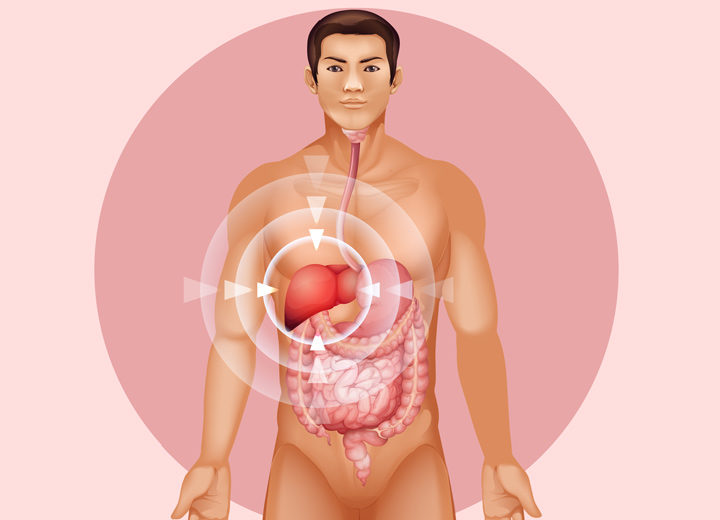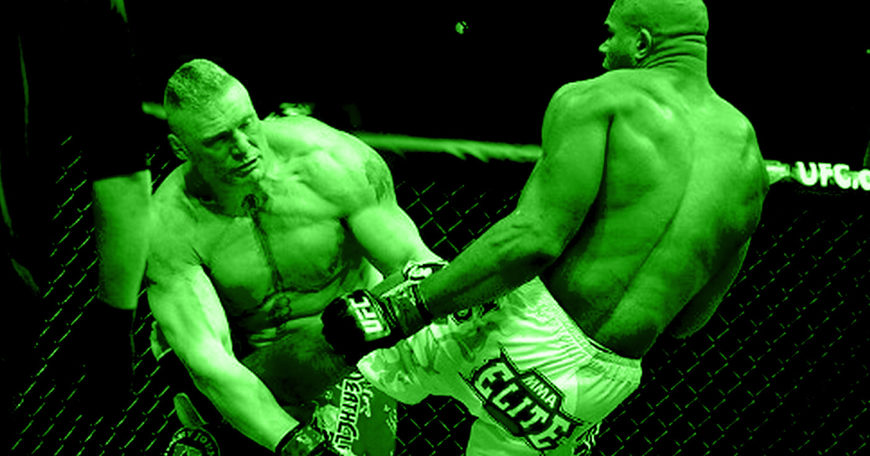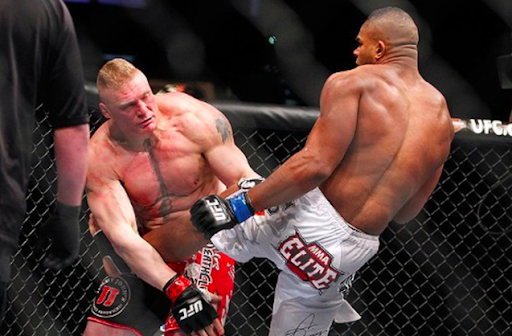The liver shot is an often debilitating strike that can be delivered by punches, knees or kicks. Most commonly, the left hook to the body is used to target the liver, but depending on your sport, a combination of all three may be used.
In boxing, body shots, especially to the liver, are often used to incapacitate opponents. In other martial arts that allow knees and/or kicks, punches to the liver are seen less often. This is for a variety of reasons, but is usually due to scoring systems that favor kicks over punches. Either way, getting hit in the liver is an excruciating and paralyzing experience, and regularly results in a technical knockout (TKO).
For this reason, they are an extremely effective tool to have in your arsenal.
Anatomy

The liver is the largest gland organ in the body. Weighing about 3 lbs, it carries out about 500 essential tasks in the body, including detoxification, converting and storing glucose, and protein synthesis.
It is also the only organ in the human body that can regenerate. The liver takes up most of the right abdominal cavity, as well as part of the chest cavity, wrapping around the body into the back of the rib cage.
Situated around the 9th and 10th ribs, it appears to be protected, like many of our organs, by the ribcage. However, the lowest two ribs are known as ‘floating ribs’, and are only attached to the vertebrae at the back, not the sternum at the front. As a result, they do not wrap around the body like the others do, leaving the lower portion of the liver in a vulnerable position, with only a thin layer of muscle to protect it.
What Happens When You Get Hit in the Liver?
Some report instant pain, while for others, this pain is slightly delayed. Regardless, the pain is typically long-lasting, and once hit in the right spot, it’ll leave you unable to continue the fight. The pain will feel like an electric shock accompanied by a feeling of breathlessness. This searing pain is due to the fact that getting hit in the liver triggers the autonomic nervous system, which automatically shuts down your body. This happens because the organ is pliable and when one end suffers a blow, it compresses, thus causing the other end to expand.
This, in turn, affects the vagus nerve, which runs from the brain down to the abdomen, and is responsible for many of our sensory and motor functions. The shutdown causes you to fall to the ground involuntarily, usually on your right side so that the liver is protected by the ground. You will remain totally conscious, but with scarce control over your body. Whether you want to continue the fight or not, the decision is usually out of your hands.
Not all liver shots will have a knockout effect, but they do sap energy and drastically decrease your available resources if continuously targeted. Extreme fatigue can manifest as a sloppy guard, taking unnecessary shots to buy time and even a reduction in the will to continue a fight.
Are Body Shots Worse than Head Shots?

That depends. On a once off basis, yes, liver shots are more painful and more debilitating than most strikes to the head. Neither the liver or the solar plexus are well protected, like the brain is, leaving them to be more at risk during a fight.
The skull is a formidable structure. A concussion, or indeed, a knockout is not due to the brain being struck by a punch. It occurs when the brain moves around the skull after an impact. The resulting twisting and pulling that occurs on the brainstem causes a short circuit that shuts off part or parts of the brain. This can affect balance, vision, and of course, consciousness.
Fighters are capable of withstanding many accurate strikes to the head in a fight without suffering immediate consequences or much pain for that matter. The same cannot be said for the liver shot. An accurate liver shot does not even require full power to bring someone down to the ground. And it is much harder to condition this area to endure the blow.
However, over a sustained period of time, headshots can have deadly consequences. Brain injuries have caused plenty of deaths in boxing and other sports that allow headshots. And there is often a recent concussion or pre-existing blood clot that contributes to this outcome. It is also a well-known fact that repeated brain trauma can result in permanent brain damage and impairment in the future. Conversely, while it is possible to die from a liver shot, it is very rarely seen in martial arts. It normally requires a much stronger blunt force trauma, such as in American football, to cause a potentially fatal rupture.
Related: Best Head Gear For Boxing And MMA Reviewed
How to Perform the Liver Shot
The left hook to the body is most effective when it is thrown as a ‘shovel punch’. This is a mix between a regular hook and an uppercut and is performed best at close range.
- In your stance make sure your feet are firmly planted and weight is evenly distributed between both legs.
- Wind up the left side by sitting into the left hip to load for power. Make sure to keep your eyes on the target and guard up by the chin.
- Turn the foot, and hip in before finally releasing the arm at around 45 degrees. Aim to punch through and up, delivering the punch just below the ribs.
Boxing Set-Ups for the Liver Shot
Strikes are most effective when the opponent doesn’t expect them and the area is unprotected. Body shots are often set up by head strikes as this draws the guard upward, leaving the body exposed. Sometimes it only takes one perfect shot, while other times, a few will be needed to wear the opponent down. If your sport allows kicks, they can be used alongside punches to target the liver. Whatever your discipline, make sure to throw high-low combinations to keep your opponent guessing and your striking unpredictable.
1- Jab, cross, liver shot
This combo gauges distance and draws the guard upwards with the jab. The cross is used to step into a closer range and keep the opponent busy up top, thus creating an opening for the liver shot.
2- Double jab, overhand, liver shot
Similar to the above combo but with an added jab to distract from the following overhand. Overhands can be knockout strikes themselves and should be used sparingly, but are an excellent precursor to the liver shot because of the downward motion and power used that also perfectly load the left side for the liver shot.
3- Left hook to the head, liver shot, follow up
Hooks to the head can put an opponent off balance even if they are blocked, due to their force. To block this punch, the opponent must bring their right arm up to protect the head, leaving the right side of the body extremely exposed. This is an opportunity to strike the liver and follow up with successive punches if necessary.
How to Block the Liver Shot
- Your guard is the most important thing to consider to prevent getting hit by the body shot. Elbows should be pointing down to the floor, as well as tucked in if possible, and if your sport allows. This keeps the guard close to the body so that it is as quick, and easy as possible to squeeze the arms and elbows in to protect the liver.
- Adjusting your stance is also a good idea. Rather than standing square on in front of your opponent, turn towards your dominant side slightly. Rather than having your navel point straight ahead, twist your torso towards your rear, so that it now lines up above the rear leg. This positions the liver further away from an aggressor making it slightly harder to hit.
- While it’s impossible to condition the liver to take shots, you can condition the arms and abdominal area to help soften the blow. This can be done by getting hit with med balls in a controlled manner or asking a training partner to strike the area at a reduced power. The arms can break when blocking multiple body shots so it is important to condition this area so that it is used to the impact. Additionally, training the obliques and abdominal wall can also help to reduce impact.
How to Recover from a Liver Shot
It is impossible to fully condition the liver for impact, however, there are exercises that help to prepare the body for impact, strengthening the body around the liver.
1– During a fight, when you’ve been hurt, one of the most important things to do as much as possible is to not let your opponent know that you have been affected by a strike. Showing injury or weakness alerts your opponent that he has been effective and will likely try to follow up or further target that area. Masking pain is something that is trained in many martial arts as it can also affect scoring in some sports. Since judges have no way of truly assessing pain or strike effectiveness, they rely on sound and physical reactions to help them decide how to score a round.
2– The next thing to try is to change the fighting range. You can do this by either returning to long-range where long straight punches are more commonly used and hooks to the body are harder to achieve. Or, alternatively, you can close the gap, moving into clinch range, where it is too close to get a heavily loaded body shot off. However, neither of these are foolproof. It is always possible to use a long-range combo to set up and step into body shot range, and it is still possible for body shots to be thrown at clinch range unless you are able to tie up their arms to prevent this from happening.
3– As a last ditch attempt, you can hold your right hand on the area and apply pressure, and try to recover your breathing as much as possible. This should only be done when you have run out of all other options
Conclusion
The liver shot has tremendous knockout (TKO) power. They wear down any opponent blow by blow, draining their already limited energy resources. One or two well placed strikes can immediately end a fight. They should be included in every fighter’s weaponry.
The best liver shots are a combination of accuracy and timing. Drill and practice on the bag as often as possible, finding out which combinations work best for your style. They may not be the easiest strike to master, but they are definitely worth it.










